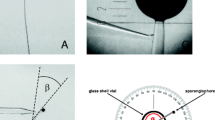Summary
The cellular slime moldDictyostelium mucoroides-7 (Dm 7) and its mutant (MF 1) exhibit sexual or asexual development depending upon culture conditions. During the sexual cycle macrocyst formation occurs, whereas sorocarps containing spores and stalk cells are asexually formed. As previously reported, the macrocyst formation is marked by the emergence of true zygotes, and is induced by a potent plant hormone, ethylene. The concentration of ethylene required for macrocyst induction was determined to establish the similarity of ethylene action between this organism and higher plants. Macrocysts are induced by low (1 μl/l) exogenous concentrations of ethylene. Higher concentrations (10–1,000 ul/l) also gave essentially the same inductive activity. Ethionine, an analogue of methionine, was found to inhibit zygote formation during sexual development through its interference with ethylene production by Dm 7 and MF 1 cells. In fact, the inhibitory effect of ethionine was mostly nullified by the application of ethylene, S-adenosyl-L-methionine, or 1-aminocyclopropane-1-carboxylic acid. Taken together these results suggest that both the effective concentration of ethylene and the pathway of ethylene biosynthesis inD. mucoroides may be similar to those in higher plants. Ethylene was also found to be produced in various species and strains of cellular slime molds, even during the asexual process. The possible functions of ethylene in the asexual development are discussed in relation to cell aggregation and differentiation.
Similar content being viewed by others
Abbreviations
- SAM:
-
S-adenosyl-L-methionine
- ACC:
-
1-aminocyclopropane-1-carboxylic acid
- AOA:
-
(aminooxy) acetic acid
- BSS:
-
Bonner's salt solution
- DAPI:
-
4′,6-diamidino-2-phenylindole
References
Abe T, Maeda Y (1986) Induction of macrocyst germination in the cellular slime mouldDictyostelium mucoroides. J Gen Microbiol 132: 2787–2791
Abeles FB (1973) Ethylene in plant biology. Academic Press, New York
Adams DO, Yang SF (1979) Ethylene biosynthesis: identification of 1-aminocyclopropane-1-caroxylic acid as an intermediate in the conversion of methionine to ethylene. Proc Natl Acad Sci USA 76: 170–174
Alix JH (1982) Molecular aspects of the in vivo and in vitro effects of ethionine, an analog of methionine. Microbiol Rev 46: 281–295
Amagai A (1984) Induction by ethylene of macrocyst formation in the cellular slime moldDictyostelium mucoroides. J Gen Microbiol 130: 2961–2965
— (1987) Regulation of the developmental modes inDictyostelium mucoroides by cAMP and ethylene. Differentiation 36: 111–115
— (1989) Induction of zygote formation by ethylene during the sexual development of the cellular slime moldDictyostelium mucoroides. Differentation 41: 176–183
—, Filosa MF (1984) The possible involvement of cyclic AMP and volatile substance(s) in the development of a macrocyst-forming strain ofDictyostelium mucoroides. Devel Growth Differ 26: 583–589
— —, Ishida S, Takeuchi I (1983) Cell differentiation in a temperature-sensitive stalkless mutant ofDictyostelium discoideum. J Embryol Exp Morphol 74: 235–243
Amrhein N, Wenker D (1979) Novel inhibitors of ethylene production in higher plants. Plant Cell Physiol 20: 1635–1642
Blaskovics JC, Raper KB (1957) Encystment stages ofDictyostelium. Biol Bull 113: 58–88
Bonner JT (1947) Evidence for the formation of cell aggregates by chemotaxis in the development of the slime moldDictyostelium discoideum. J Exp Zool 106: 1–26
— (1967) The cellular slime molds, 2nd edn. Princeton University Press, Princeton
— (1973) Hormons in social amoebae. In: J Lobne, AS Gordon (eds) Humoral control of growth and differentiation, vol 2. Academic Press, New York, pp 84–98
Broglie KE, Gaynor JJ, Brogue RM (1986) Ethylene-regulated gene expression: molecular cloning of the genes encoding an endochitinase fromPhaseolus vulgaris. Proc Natl Acad Sci USA 83: 6820–6824
Chagla AH, Lewis KE, O'Day DH (1980) Ca2+ and cell fusion during sexual development in liquid cultures ofDictyostelium discoideum. Exp Cell Res 126: 501–505
Chalutz E, Lieberman M, Sisler HD (1977) Methionine-induced ethylene production byPenicillium digitatum. Plant Physiol 60: 402–406
Chou TW, Yang SF (1973) The biosynthesis of ethylene inPenicillium digitatum. Arch Biochem Biophys 157: 73–82
Filosa MF (1979) Macrocyst formation in the cellular slime moldDictyostelium mucoroides: involvement of light and volatile morphogenetic substance(s). J Exp Zool 207: 491–495
— (1987) Induction of fruiting bodies in a macrocyst-forming mutant of the cellular slime mold,Dictyostelium mucoroides. Differentiation 33: 185–192
—, Dengler RE (1972) Ultrastructure of macrocyst formation in the celluar slime moldDictyostelium mucoroides: extensive phagocytosis of amoebae by a specialized cell. Dev Biol 29: 1–16
Iijima N, Amagai A, Maeda Y (1991) Involvement of cytoplasmic pH in the production of ethylene, a potent inducer of sexual development inDictyostelium mucoroides. Protoplasma 160: 72–76
Lieberman MA, Mapson LW (1964) Genesis and biogenesis of ethylene. Nature 204: 343–345
Lydan MA, O'Day DH (1988) Developmental effects of the major ions found in a ground water sample on sexual cultures ofDictyostelium discoideum. Can J Microbiol 34: 207–211
Szabo PS, O'Day DH, Chagla AH (1982) Cell fusion, nuclear fusion, and zygote differentiation during sexual development ofDictyostelium discoideum. Dev Biol 90: 375–382
Weinkauf AM, Filosa MF (1965) Factors involved in the formation of macrocysts by the cellular slime molds,Dictyostelium mucoroides. Can J Microbiol 11: 385–387
Yu YB, Adams DO, Yang SF (1979) 1-amino-cyclopropane carboxylate synthase, a key enzyme in ethylene biosynthesis. Arch Biochem Biophys 198: 280–286
Author information
Authors and Affiliations
Rights and permissions
About this article
Cite this article
Amagai, A., Maeda, Y. The ethylene action in the development of cellular slime molds: an analogy to higher plants. Protoplasma 167, 159–168 (1992). https://doi.org/10.1007/BF01403379
Received:
Accepted:
Issue Date:
DOI: https://doi.org/10.1007/BF01403379




